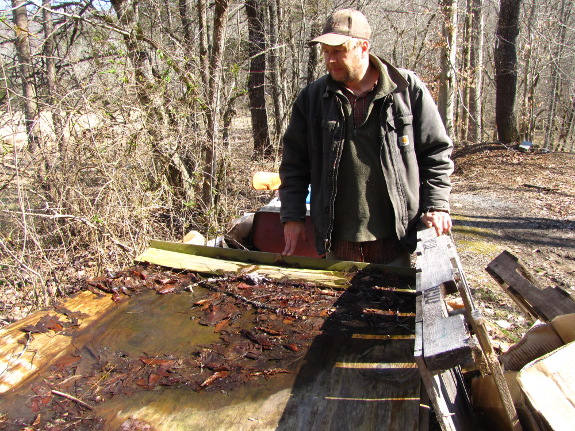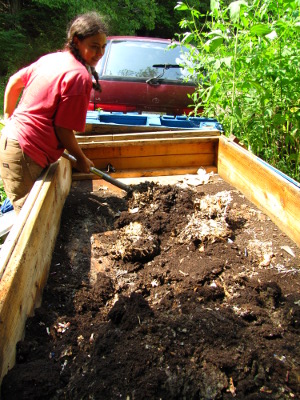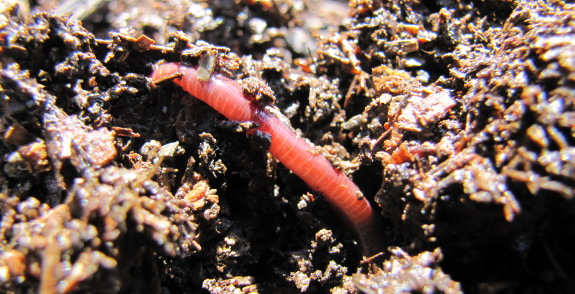
Overwintering compost worms

 Friday, the sun finally came
out and the cold weather broke. A perfect day to check on our
invertebrates! The honeybees were flying busily in and out of
their hive and even visiting the crocuses. But three of our four
worm bins were less vibrant.
Friday, the sun finally came
out and the cold weather broke. A perfect day to check on our
invertebrates! The honeybees were flying busily in and out of
their hive and even visiting the crocuses. But three of our four
worm bins were less vibrant.
I'll start out by
telling you about the one worm bin that's thriving (pictured above and
to the left). This is our first bin, located at the parking area
with a lot of winter sun. The plywood lid bowed down on one side,
so water tends to pool there and seep into the bin. Sure enough,
the area under the pool is full of thriving compost worms, but the rest
of the manure has dried out too much to host worm activity.
I'm sure not sure if the
problem with our other three bins is lack of moisture, cold, or
both. We built
the lids on those bins at a slant
so rain would run off and the wood would last longer. I started
out
the winter by saturating the manure and sawdust bedding, but sometime
over the cold months, all of the water drained away and left the
contents quite dry. Even after I opened the lid this week and let
rain
pound down on the manure, there were still lots of dry pockets when I
poked around Friday, and very few worms were left.
 The three bins in our core
homestead are also in heavy shade during the
winter, so the contents probably froze solid a few times. And
there are several other differences between our oldest bins and our
three newer bins beyond moisture and temperature. Looking back at
old photos like the one to the right, I notice that the
vibrant-worm-area is on the side of the bin where I raked
all of the finished compost and worms last August,
so maybe they just haven't spread beyond home base due to the cold
weather? Or maybe they don't like the horse-manure-in-sawdust as
much
as they liked the original horse-manure-in-straw? Or maybe
variety is
the deciding factor since the
worms that went into the core homestead bins
were purchased from a different location than the locally-adapted worms
that went into our original bin.
The three bins in our core
homestead are also in heavy shade during the
winter, so the contents probably froze solid a few times. And
there are several other differences between our oldest bins and our
three newer bins beyond moisture and temperature. Looking back at
old photos like the one to the right, I notice that the
vibrant-worm-area is on the side of the bin where I raked
all of the finished compost and worms last August,
so maybe they just haven't spread beyond home base due to the cold
weather? Or maybe they don't like the horse-manure-in-sawdust as
much
as they liked the original horse-manure-in-straw? Or maybe
variety is
the deciding factor since the
worms that went into the core homestead bins
were purchased from a different location than the locally-adapted worms
that went into our original bin.
Still, moisture is my
best guess, and I have a way to test my hypothesis. As I empty
out the core homestead bins to add manure to the garden, I should
eventually hit a wetter area near the bottom of the bins. If the
damp zone is full of worms, I'll know water was the difference between
the bin that thrived and the bins that didn't.

Mark's already talking
about ways to let rainwater soak in without losing the shade effect of
the lid in the summer --- perhaps drilling holes at intervals
throughout the lid might work. Other ideas for hydration that
don't require running hoses during freezing weather are appreciated.
Want more in-depth information? Browse through our books.
Or explore more posts by date or by subject.
About us: Anna Hess and Mark Hamilton spent over a decade living self-sufficiently in the mountains of Virginia before moving north to start over from scratch in the foothills of Ohio. They've experimented with permaculture, no-till gardening, trailersteading, home-based microbusinesses and much more, writing about their adventures in both blogs and books.
Want to be notified when new comments are posted on this page? Click on the RSS button after you add a comment to subscribe to the comment feed, or simply check the box beside "email replies to me" while writing your comment.

Anna,
Have you considered using a couple of layers of burlap, like old potato sacks, to make the worm bin roof? You might be able to build a simple frame out of chicken wire and lay the burlap or landscape fabric right on top. I find the material indespinsable as it can be used to make harvest bags, provide shade for summer lettuce, store grains for animal feed, store roots for the cellar, etc.. The list goes on and on! You can usually get old potato sacks from feed &seed stores after they have sold spring seed tubers. Hope you figure it out soon, as we too are preparing to build a few worm bins and could use the info!
All the Best, Robert